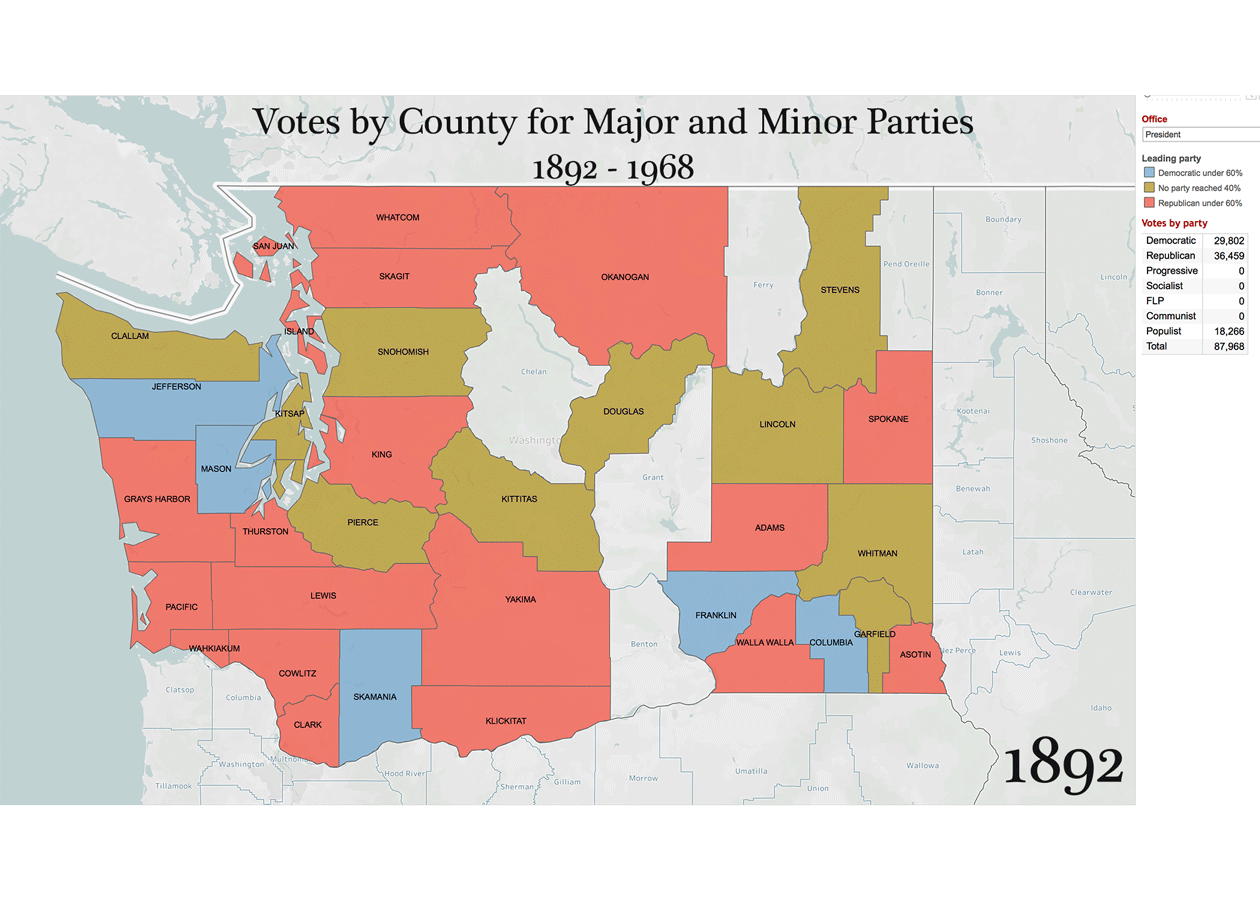Washington State Historic Votes by Counties 1892-1968
 Washington State has a distinct political history, at times more progressive or radical than most other states - but not always. For much of its history Washington was a Republican stronghold, although sometimes that meant the progressive wing of the Republican Party. And third parties have also been active. The map below shows voting patterns by counties for every statewide election from 1892-1969. It is filled with surprises. Counties that today are known for conservativism voted for radicals and progressives decades ago. And King County, now the heartland of liberal voting, has not always been so.
Washington State has a distinct political history, at times more progressive or radical than most other states - but not always. For much of its history Washington was a Republican stronghold, although sometimes that meant the progressive wing of the Republican Party. And third parties have also been active. The map below shows voting patterns by counties for every statewide election from 1892-1969. It is filled with surprises. Counties that today are known for conservativism voted for radicals and progressives decades ago. And King County, now the heartland of liberal voting, has not always been so.
Keep your eye on green and brown colors as you move through the maps. These indicate counties where third party populist, progressive, or socialist campaigns won pluralities. In the 1890s, the People's Party (Populists) elected candidates to local and state offices, most importantly John R. Rogers who was elected governor in 1896 on a Populist-Democratic fusion ticket. The Socialist Party became increasingly effective in elections after 1904, winning some local offices and securing more than 40,000 votes for Eugene Debs in the 1912 presidential campaign. In that same election, Teddy Roosevelt, running as a candidate of the Progressive Party, carried the state. In 1920, radicals launched a the Farmer Labor Party (FLP) in Washington and several other states. Running for governor, Seattle labor leader Jimmy Duncan gained more than 120,000 votes for the new party, coming in second ahead of the Democratic candidate. Four years later, with Socialist Party backing, Senator Robert LaFollette secured 146,000 votes running under the Progressive Party banner for President. Socialist and Communist candidates continued to appear on the ballot though the 1940s but the electoral energies of radicals had shifted to the Washington Commonwealth Federation and its campaign to support and radicalize the Democratic Party. The last significant third party effort took shape in 1948 when former Vice President Henry Wallace challenged Harry Truman and Wendel Wilkie with a new Progressive Party that was energetically backed by the Communist Party. He gained only 31,000 votes in Washington. Also disappointing was the attempt to win votes in 1968 for the Peace and Freedom Party, that had been launched in California. Less than 2,000 voters responded to the last minute campaign.
These and other campaigns are captured in the maps below that combine votes for all progressive and radical parties to assess the strength of radical support from 1892 to 1968. Another map moves shows the shifting balance between Republicans and Democrats across the same decades. These maps are hosted by Tableau Public and may take a few seconds to respond. If slow, refresh the page.
Sources: Vote charts and maps are based on data from Inter-university Consortium for Political and Social Research. United States Historical Election Returns, 1824-1968 [Computer File]. ICPSR00001-v3. Ann Arbor, MI: Inter-university Consortium for Political and Social Research [distributor], 1999-04-26. http://doi.org/10.3886/ICPSR00001.v3.
Research and data compilation: James Gregory
Maps: James Gregory